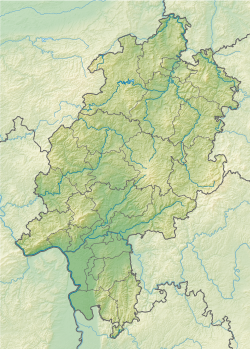Composition, Dimensions, and Geometry
Riesenstein is composed of Neogene Miocene (from 23 million years ago to 8 million years ago) quartzite. In contrast to quartzites produced by metamorphism, the Tertiary sedimentary quartzites were the product of intense weathering of local Triassic Buntsandstein sandstones in a tropical climate. This entailed bleaching of sandstone and silicification by movement of silica-saturated groundwater through the strata. Consequently, the rock is practically made completely of quartz, with very little porosity. [1] [2]
The megalith has an oblate rectangular cuboid shape. It has a maximum height of 4.7 m (15 ft), a maximum width of 4.6 m (15 ft), and it is approximately 1 m (3 ft 3 in) thick. A rough estimate of the surface area of the flat large side is 14 m2 (150 sq ft). Hence the Riesenstein has an above-ground volume of ca. 14 m3 (490 cu ft). Quartzite is composed wholly of quartz, which has a density of 2,648 kg/m3 (4,463 lb/cu yd). Therefore, the above-ground mass of the stone is ca. 37 metric tons (36 long tons). For comparison, the sarsen (also a kind of silicified sandstone that resulted from Cenozoic acid leaching) [3] stones of Stonehenge only weigh ca. 7 metric tons (6.9 long tons).
The weak, originally-horizontal bedding planes of the quartzite are now vertical, which rules out the stone being in a natural position. Furthermore, the surrounding area (in the wood) is covered with small blocks of quartzite, as are many other nearby hills, proving that Tertiary quartzite outcrops or is close to the surface in these places. Riesenstein is therefore unlikely to have been transported far, if at all.
Legends
Two legends are connected with the Riesenstein. [5] [6]
In the wide floodplain [of the Eder River], monks and men from the neighbouring villages built a large monastery. The building took a long time. Finally the Breitenau Monastery was finished and pious monks' song could be heard mixed with the first chimes of the monastery bells. For a long time a malicious giant on the Lotterberg hill had been watching the festivities. Now he couldn't hold back his anger and hate any more. He ripped up a huge rock and threw it with all his might at the monastery to reduce it to rubble. But in his haste he threw wrongly and the stone dropped before it passed the Ellenberg hill on the other side of the Eder River. The stone is still present and admonishes future generations to past events.
In a different story, two male giants had a fight over the giantess Nagathe, because they were both in love with her. Nagathe had moved in with the Giant Lothar on Lotterberg, but his rival Kunibert wouldn't accept this. Kunibert left his home at Heiligenberg and kidnapped Nagathe in front of Lothar. In a mad fury Lothar threw a large stone at his disappearing rival, but he missed and the stone was rammed into the soft ground. Because this story was often told, the stone was given the name "giant's stone".

Stonehenge is a prehistoric monument on Salisbury Plain in Wiltshire, England, two miles (3 km) west of Amesbury. It consists of an outer ring of vertical sarsen standing stones, each around 13 feet (4.0 m) high, seven feet (2.1 m) wide, and weighing around 25 tons, topped by connecting horizontal lintel stones. Inside is a ring of smaller bluestones. Inside these are free-standing trilithons, two bulkier vertical sarsens joined by one lintel. The whole monument, now ruinous, is aligned towards the sunrise on the summer solstice. The stones are set within earthworks in the middle of the densest complex of Neolithic and Bronze Age monuments in England, including several hundred tumuli.

The Taunus is a mountain range in Hesse, Germany, located north west of Frankfurt and north of Wiesbaden. The tallest peak in the range is Großer Feldberg at 878 m; other notable peaks are Kleiner Feldberg and Altkönig.

Fritzlar is a small town in the Schwalm-Eder district in northern Hesse, Germany, 160 km (99 mi) north of Frankfurt, with a storied history.

The Coffin Stone, also known as the Coffin and the Table Stone, is a large sarsen stone at the foot of Blue Bell Hill near Aylesford in the south-eastern English county of Kent. Now lying horizontally, the stone probably once stood upright nearby. Various archaeologists have argued that the stone was part of a now-destroyed chambered long barrow constructed in the fourth millennium BCE, during Britain's Early Neolithic period.

Felsberg is a town in the Schwalm-Eder district about 25 kilometres south of Kassel.
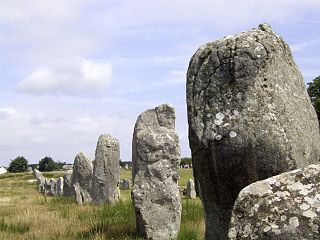
The Carnac stones are an exceptionally dense collection of megalithic sites near the south coast of Brittany in northwestern France, consisting of stone alignments (rows), dolmens, tumuli and single menhirs. More than 3,000 prehistoric standing stones were hewn from local granite and erected by the pre-Celtic people of Brittany and form the largest such collection in the world. Most of the stones are within the Breton municipality of Carnac, but some to the east are within neighboring La Trinité-sur-Mer. The stones were erected at some stage during the Neolithic period, probably around 3300 BC, but some may date to as early as 4500 BC.

Baunatal is a town in the district of Kassel, in Hesse, Germany. It is a comparatively young town which arose from fusion of the formerly independent municipalities Altenbauna, Altenritte, Großenritte, Guntershausen, Hertingshausen, Kirchbauna and Rengershausen in 1966.

Silcrete is an indurated soil duricrust formed when surface soil, sand, and gravel are cemented by dissolved silica. The formation of silcrete is similar to that of calcrete, formed by calcium carbonate, and ferricrete, formed by iron oxide. It is a hard and resistant material, and though different in origin and nature, appears similar to quartzite. As a duricrust, there is potential for preservation of root structures as trace fossils.
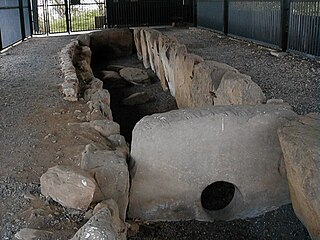
The Züschen tomb is a prehistoric burial monument, located between Lohne and Züschen, near Fritzlar, Hesse, Germany. Classified as a gallery grave or a Hessian-Westphalian stone cist, it is one of the most important megalithic monuments in Central Europe. Dating to the late 4th millennium BC, it belongs to the Late Neolithic Wartberg culture. The presence of incised carvings, comparable to prehistoric rock art elsewhere in Europe, is a striking feature of Wartberg culture tombs, known so far only from Züschen and from tomb I at Warburg.

Wolfershausen is one of the sixteen constituent communities that form the town of Felsberg in Schwalm-Eder-Kreis, North Hesse, Germany.

Heiligenburg Castle is a castle on the hill of Heiligenberg in the district of Schwalm-Eder-Kreis, Hesse, Germany.

Lotterberg is a 305 m (1,001 ft) (NHN) high hill between the villages of Wolfershausen and Deute in Schwalm-Eder-Kreis, Hesse, Germany.
Mader Stein, or Maderstein, is a 265 m (869 ft) (NHN) high hill in North Hesse, Schwalm-Eder-Kreis, north-east of the village of Maden, which belongs to the town of Gudensberg.
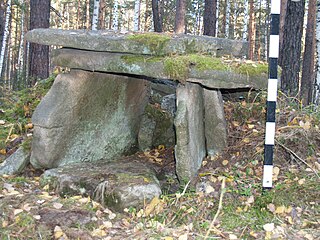
In recent years, many megaliths have been discovered in the Urals: dolmens, menhirs and a large megalithic cultic complex on Vera Island.
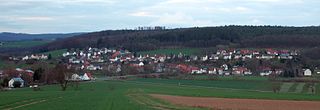
Altenbunslar is a small village in North Hesse, Germany. It is part of the town Felsberg.

The Wotanstein, also known as 'Wodanstein' or earlier on 'Malstein', is a small megalith or menhir situated close to the village of Maden, Schwalm-Eder-Kreis, Hesse, Germany.
The Hahn is a 255.8 m (839 ft)-high basalt knoll in the district of Schwalm-Eder-Kreis, within the town of Edermünde-Holzhausen, in Hesse, Germany. Like many other basalt outcrops in the West Hesse Depression, it is the neck of an extinct Miocene volcano, the rest has been eroded. A small medieval tower castle once stood on the hill.

The Vogelsberg (help·info) is a large volcanic mountain range in the German Central Uplands in the state of Hesse, separated from the Rhön Mountains by the Fulda river valley. Emerging approximately 19 million years ago, the Vogelsberg is Central Europe's largest basalt formation, consisting of a multitude of layers that descend from their peak in ring-shaped terraces to the base.

St. Wendel is the name of a Catholic parish and church in Frankfurt-Sachsenhausen, Hesse, Germany, dedicated to Wendelin of Trier. The official name of the church is Kath. St. Wendelskirche. It was built from 1955 to 1957, designed by architect Johannes Krahn.

